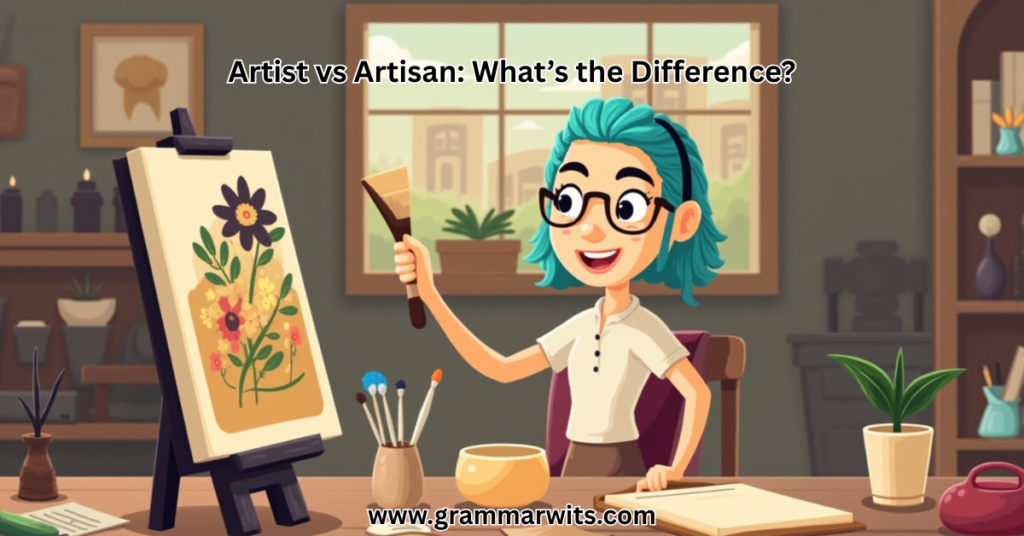The distinction between an artist and an artisan lies in the focus, purpose, and approach to their respective crafts. An artist is typically defined as someone who creates visual, performing, or literary works that express imagination, emotion, or a concept. They aim to evoke feelings or challenge societal norms. On the other hand, an artisan is a skilled craftsperson who focuses on creating functional, handcrafted objects using traditional techniques and materials. While both forms of creativity demand dedication and skill, their motivations and outputs vary significantly. Artist vs Artisan What is the Difference is a common topic among creatives and craft enthusiasts.
The world of art and craftsmanship is filled with fascinating contrasts, where the lines between artistic expression and practical creation blur. Exploring the nuances of these two roles offers deeper insight into the diverse forms of creativity that shape our world. The difference between an artist and an artisan reveals not just their techniques but their unique contributions to culture and society. Many people search Artist vs Artisan What is the Difference to better understand the roles of creativity and skill in both fields.
Understanding the differences between artists and artisans sheds light on how each plays an essential role in both functional and aesthetic spheres. While artists prioritize expression and boundary-pushing, artisans uphold craftsmanship and tradition, ensuring that beauty meets purpose. This exploration helps appreciate the value and significance each brings to their craft and the world at large. Artist vs Artisan What is the Difference is a key phrase in debates about creativity, skill, and professional identity.
The Historical Evolution of Art vs. Craft
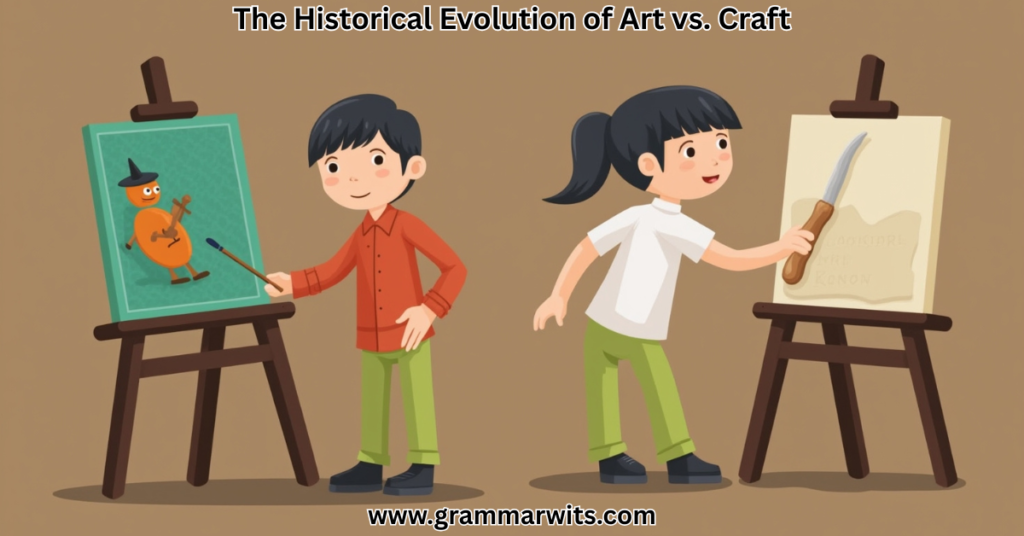
The distinction between artist and artisan hasn’t always existed as we understand it today. In medieval Europe, creative workers belonged to guilds where skilled craftspeople produced everything from illuminated manuscripts to cathedral stonework. The concept of “art for art’s sake” simply didn’t exist.
During the Renaissance, a significant shift occurred. Creators like Leonardo da Vinci and Michelangelo elevated visual expression beyond mere craft, establishing the concept of “fine arts.” This period marked the first major separation between what we now consider artistic processes versus craftsmanship.
“In ancient Greece, there was no word for ‘art’ in the sense we understand it today. Their term ‘techne’ encompassed both what we would call fine arts and craftsmanship.” – Dr. Ellen Dissanayake, anthropologist and author
The Industrial Revolution further widened this gap. As mass production replaced handwork, artisans became increasingly rare and specialized. Meanwhile, artists gained cultural status as unique visionaries whose work transcended practical use.
Today, we’re experiencing a fascinating reconnection between these worlds. The maker movement celebrates both artistic vision and technical skill, while digital platforms allow creators to share their work regardless of how it’s categorized. When discussing creative careers, Artist vs Artisan What is the Difference is an essential concept to define.
Who Is an Artist?

An artist is fundamentally a creator whose primary purpose centers on self-expression and communicating ideas, emotions, or perspectives. Their work often aims to provoke thought, evoke feeling, or challenge perceptions rather than serve a practical function.
Key Characteristics of Artists:
- Driven by personal artistic vision and conceptual intent
- Often works without predetermined functional requirements
- Values originality and individual expression above all
- Typically recognized for their distinctive style or voice
- Works primarily in visual art, music, literature, performance, or interdisciplinary media
- Often explores abstract concepts, emotions, and social commentary
Artists typically train through formal education at art schools or universities, though many are self-taught. Their success is often measured through gallery representation, critical acclaim, grants, and cultural impact rather than strictly commercial metrics.
The notion of the artist as a special cultural figure emerged relatively recently in human history. Before the Renaissance, those we might now call artists were simply considered skilled workers. Today, however, we understand that the artistic medium serves as a vehicle for deeper communication.
Who Is an Artisan?

An artisan is a master maker who creates objects that balance beauty and utility. They combine traditional skills with deep material knowledge to produce items of exceptional quality and craftsmanship.
Essential Traits of Artisans:
- Masters traditional methods and techniques through years of practice
- Works primarily with physical materials (wood, metal, clay, fiber, glass, etc.)
- Creates functional objects with aesthetic appeal
- Values excellence in execution and mastery of technique
- Often preserves cultural traditions while adding personal touches
- Produces work showing exceptional attention to detail and quality
Artisans typically learn through apprenticeships, technical schools, or direct mentorship. Their training emphasizes hands-on techniques and material understanding over abstract theory. Success for artisans often comes through developing a loyal customer base who values the quality and character of handmade work.
The modern appreciation for artisanal work represents a significant shift from mid-20th century values that prioritized mass production. Today’s consumers increasingly seek the authenticity, quality, and human connection inherent in handcrafted objects.
Artist vs Artisan: Core Differences
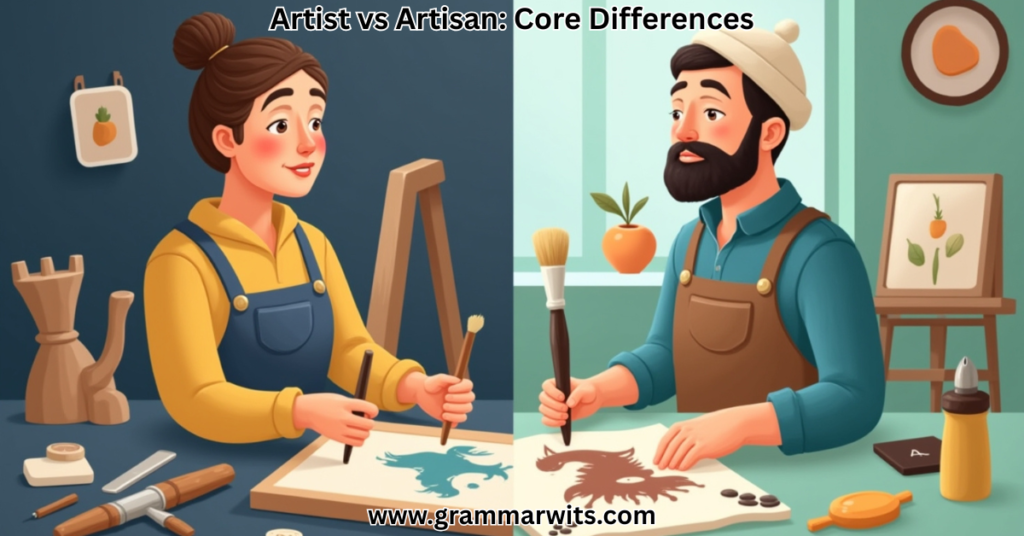
The difference between artists and artisans manifests across several key dimensions that shape how they work and what they create.
Intent and Purpose
Artists create primarily to express ideas, emotions, or perspectives. Their work may challenge, provoke, or inspire, but rarely serves a practical function beyond communication and aesthetic experience.
Artisans create objects that serve practical purposes while embodying beauty and quality. Their work balances form and function, with utility remaining central to the creation process.
Training Paths
| Artists | Artisans |
|---|---|
| Often formally educated in fine arts programs | Usually trained through apprenticeships or vocational education |
| Study theory, criticism, and conceptual approaches | Learn technical skills directly from master practitioners |
| Encouraged to develop unique personal style | Taught established traditions and techniques |
| Focus on developing individual voice | Focus on mastering standardized techniques |
Process Focus
Artists often prioritize innovation and personal expression in their process. They may invent new techniques or combine existing ones in unexpected ways to achieve their vision. The emphasis lies on the conceptual approach and emotional impact of the final work.
Artisans typically focus on refinement and mastery of established techniques. Their innovation comes through subtle improvements to traditional methods and adapting them to contemporary needs while maintaining high-quality craftsmanship.
“The artist creates for contemplation, the artisan for utilization.” – Robert Schumann
Relationship with Tradition
Artists often position themselves in relation to artistic traditions—either extending them or deliberately breaking with them. Art history provides context but can also represent constraints to push against.
Artisans generally work within traditions, seeing themselves as links in a long chain of practitioners. They value the accumulated wisdom of traditional methods while making subtle personal adaptations.
Where They Overlap: The Gray Areas

While the distinctions between artist and artisan help us understand different creative approaches, many talented creators work across these categories or defy easy classification altogether.
Case Study: Furniture Maker Sam Maloof
Sam Maloof (1916-2009) created functional furniture while achieving recognition in the fine art world. His iconic rocking chairs represent both flawless craftsmanship and distinctive artistic vision. Major museums include his work in their permanent collections, yet each piece remains thoroughly functional.
What makes someone like Maloof transcend categories? His work demonstrates:
- Exceptional technical execution
- Distinctive personal style
- Historical awareness combined with innovation
- Both functional success and emotional/aesthetic impact
Social Media’s Role in Blurring Boundaries
Platforms like Instagram have fundamentally changed how creators present their work, often blurring the artist vs artisan distinction. A potter might photograph their functional vessels with the same aesthetic consideration once reserved for fine art, while a painter might sell merchandise featuring their images.
This democratization of visual culture has positive aspects—allowing talented creators to find audiences regardless of how the art establishment categorizes them—but can also create confusion about the different values and purposes each approach represents.
Etymology and Language Evolution
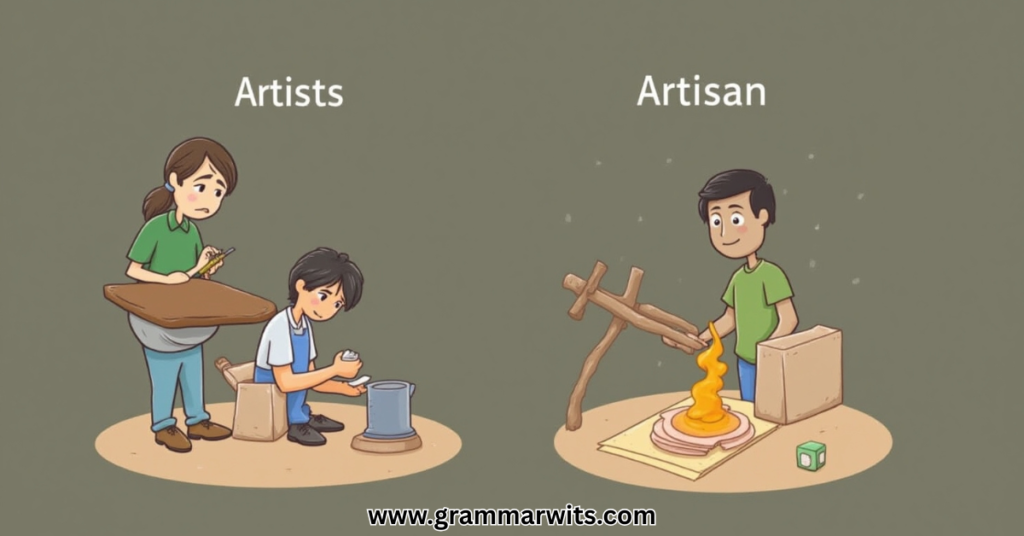
The words themselves reveal much about how our conception of creative work has evolved throughout history.
Origins of “Artist”
The term artist derives from the Latin word “ars,” meaning skill or craft. Interestingly, its original meaning was much closer to what we now call an artisan. During the 16th-century English Renaissance, the meaning shifted toward creative innovation rather than technical skill alone.
By the 18th century, “artist” had acquired its modern connotation of someone working primarily for expressive purposes rather than utility. This linguistic evolution reflects the cultural elevation of fine arts above applied crafts during this period.
Origins of “Artisan”
Artisan entered 1530s English from French, ultimately deriving from Latin “artitianus,” meaning skilled in the arts. It has maintained its connection to skilled handcraft throughout its history.
The term experienced a decline in use during the industrial era but has enjoyed a significant revival in recent decades as consumers seek alternatives to mass production and reconnection with human-made objects.
Language Reflecting Cultural Values
The separation of these terms reflects broader cultural hierarchies that emerged during the Renaissance and Enlightenment. As societies developed class distinctions based on types of labor, creative work became stratified between “intellectual” arts and “manual” crafts—a distinction that often reflected class biases more than meaningful differences in skill or creativity.
Real-World Examples: Artists and Artisans at Work

To better understand the difference between artists and artisans, let’s examine some notable examples from each domain.
Notable Artists and Their Impact
Yayoi Kusama – A Japanese visual art pioneer whose immersive installations transform spaces with repetitive patterns and mirror works. Her art expresses her unique psychological experiences and vision, prioritizing conceptual impact over functionality.
Marina Abramović – A Serbian performance artist who uses her body as a medium to explore limits of physical endurance, pain, and human connection. Her work exists primarily to create experiences and provoke thought rather than serve practical purposes.
Ai Weiwei – A Chinese contemporary artist whose politically charged installations and sculptures comment on human rights and social justice. His conceptual approach emphasizes the ideas behind his creations rather than strictly technical execution.
Master Artisans and Their Legacy
Lowell Eicher – A master blacksmith whose architectural ironwork combines traditional forging techniques with contemporary design sensibilities. His gates, railings, and fixtures serve practical purposes while displaying exceptional craftsmanship.
Beatrice Wood – Known as the “Mama of Dada,” Wood was primarily a potter whose lustrous glazes and functional vessels earned her recognition both as an artisan and artist, demonstrating how these categories can overlap.
George Nakashima – A Japanese-American woodworker whose furniture celebrates the natural characteristics of wood. His pieces function perfectly as tables, chairs, and cabinets while expressing deep philosophical ideas about materials and craftsmanship.
Crossover Figures
Dale Chihuly – A revolutionary glassblower whose technical innovations transformed the medium. His work ranges from functional vessels to massive architectural installations, demonstrating how mastery of craft techniques can lead to artistic recognition.
Anni Albers – A textile artist whose woven pieces function both as wall hangings and theoretical explorations of pattern, color, and texture. Trained at the Bauhaus, Albers exemplifies the school’s philosophy of uniting art and craft.
The Value Question: Economics of Art vs. Artisanship
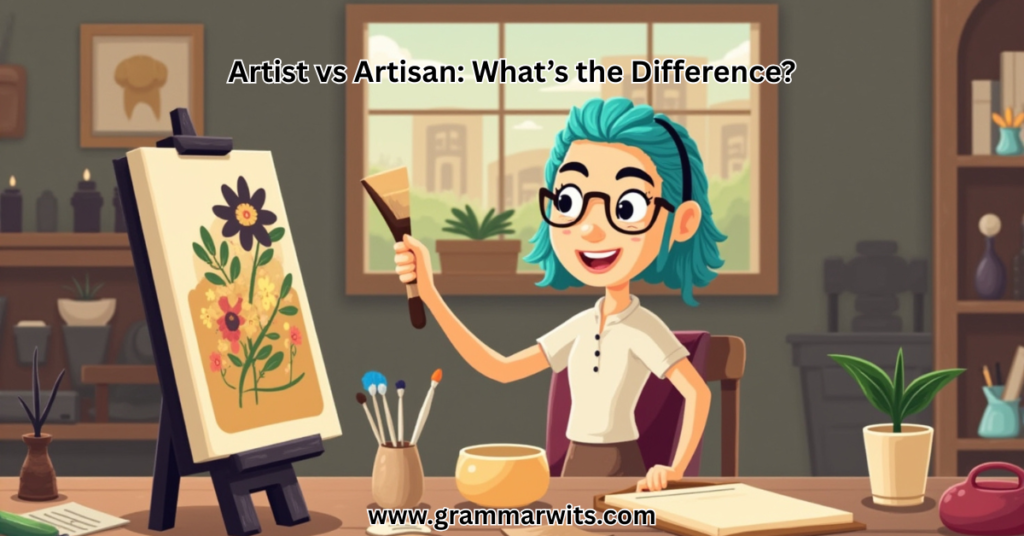
The economic structures surrounding art and craft reflect and reinforce their cultural distinctions.
Pricing Differences
Artistic works typically follow a speculative value model—pieces are priced based on the artist’s reputation, critical acclaim, and uniqueness rather than materials or labor hours. A famous artist’s work might sell for millions regardless of size or complexity.
Artisanal works generally follow a more straightforward economic model—prices reflect materials, time invested, and skill level, with some premium for reputation and exceptional quality. While high-end artisanal pieces command premium prices, they rarely reach the astronomical values of fine art.
Market Structures
| Art Market | Artisanal Market |
|---|---|
| Dominated by galleries, auction houses, and collectors | Direct sales, craft fairs, and specialized retailers |
| Value often driven by critical discourse and investment potential | Value driven by quality, utility, and aesthetic appeal |
| Pieces typically unique, one-of-a-kind | May produce multiples with variations |
| Primary and secondary markets (resale) | Primarily first-sale only |
Sustainability Considerations
The artist’s career path often involves significant financial uncertainty, with success heavily dependent on critical recognition and representation. Many supplement their income through teaching or commercial work. If you’re curious about Artist vs Artisan What is the Difference, this guide breaks it down clearly.
The artisan’s career typically offers more predictable income through consistent production and direct sales, though rarely the potential for the dramatic financial success possible in fine arts.
Digital Age Implications
Technology has profoundly impacted both artistic and artisanal practices, creating new possibilities and challenges.
Digital Artists vs. Digital Craftspeople
Digital artists use technology as a medium for self-expression and conceptual exploration. Their work might include algorithmic art, virtual reality experiences, or digital imagery meant primarily for viewing rather than practical use. The article titled Artist vs Artisan What is the Difference explains how expression and functionality separate the two.
Digital artisans apply traditional design principles and attention to detail in creating functional digital products like websites, typefaces, or user interfaces. Their work must perform practical functions while providing aesthetic satisfaction.
AI’s Impact on Creativity and Craft
Artificial intelligence tools are raising profound questions about the nature of creativity. When an AI can generate images or text based on prompts, how does this change our understanding of artistic processes? The article titled Artist vs Artisan What is the Difference explains how expression and functionality separate the two.
For artisans, computational design and digital fabrication technologies like 3D printing and CNC machining allow for new forms of precision and complexity while potentially disconnecting makers from direct material engagement.
“The hand is the cutting edge of the mind.” – Jacob Bronowski
Why This Distinction Matters Today
Understanding the difference between artists and artisans isn’t merely academic—it impacts how we support creators, preserve cultural knowledge, and value different forms of creative work.
Supporting Creators Appropriately
Artists often benefit from grants, residencies, and other forms of support that provide time and space for exploration without immediate commercial pressure.
Artisans typically need access to affordable workspace, materials, and opportunities to market their work directly to appreciative customers.
Cultural Preservation and Innovation
Traditional materials and techniques represent irreplaceable cultural heritage. Without active artisans practicing and teaching these methods, we risk losing generations of accumulated knowledge.
Simultaneously, artistic innovation pushes cultural boundaries and helps societies process change and imagine new possibilities.
Education for Different Creative Paths
Different forms of creativity require different educational approaches. Artist education often emphasizes conceptual thinking, critical theory, and developing individual voice.
Artisan training requires sustained practice, direct demonstration, and gradual mastery of physical techniques—educational models increasingly rare in contemporary academia.
The Spectrum of Creative Practice: Artist vs Artisan
Rather than viewing artists and artisans as entirely separate categories, we might better understand them as points on a spectrum of creative practice.
Key Points on the Creative Spectrum:
- Pure Fine Art – Works created solely for conceptual or emotional impact with no practical function (e.g., abstract painting)
- Applied Art – Aesthetic works with some functional aspect (e.g., art furniture, art jewelry)
- Designer Craft – Functional objects with strong aesthetic and personal expression (e.g., studio pottery)
- Traditional Craft – Functional objects made using established techniques with high skill (e.g., traditional cabinetmaking)
- Production Craft – Small-batch production of handmade functional items (e.g., production pottery)
Most creators work at different points along this spectrum at different times, and many of the most interesting works exist in the spaces between these categories.
Artist vs Artisan: A Self-Assessment
Where do you fall on the spectrum between artist and artisan? Consider these questions:
- Are you more motivated by expressing ideas or creating functional objects?
- Do you prefer inventing new approaches or mastering established techniques?
- Is uniqueness or reproducibility more important in your work?
- Do you work primarily with traditional or experimental materials?
- Is your creative satisfaction more tied to conceptual success or technical execution?
There are no right or wrong answers—many successful creators incorporate elements of both approaches. Understanding your natural tendencies can help you find the right educational path, community, and market for your work.
Famous Quotes About Art and Craft
These perspectives from notable creators highlight the complex relationship between artistic and artisanal approaches:
“Art is not what you see, but what you make others see.” – Edgar Degas
“The principles of true art is not to portray, but to evoke.” – Jerzy Kosinski
“Design is not just what it looks like and feels like. Design is how it works.” – Steve Jobs
“When love and skill work together, expect a masterpiece.” – John Ruskin
“In a world where excellence is compromised for profit, beauty must prevail.” – Beatrice Wood
Conclusion: Embracing the Full Spectrum of Creative Work
The distinction between artist and artisan helps us understand different approaches to creative work, but the most exciting territory often lies where these domains overlap and inform each other. When artistic expression meets technical mastery, when innovation enhances functionality, when conceptual approaches are realized through traditional skills—this is where some of humanity’s most compelling creations emerge. Schools and workshops often include lessons on Artist vs Artisan What is the Difference to guide students’ career paths.
Rather than maintaining rigid boundaries between art and craft, we might better appreciate the unique contributions each approach brings to our cultural landscape. The artist reminds us to question, imagine, and feel deeply. The artisan connects us to material wisdom, functional beauty, and human-scale making. Together, they represent the full spectrum of human creativity.
As consumers, collectors, and creators, understanding the difference between artists and artisans enriches our appreciation of what each offers. It helps us recognize the distinct values, economics, and purposes behind different forms of creative work, allowing us to support and celebrate both artistic vision and artisanal excellence in an increasingly mass-produced world.
Artist vs Artisan: What’s the Difference? At heart, it’s about different relationships to purpose, tradition, and expression—differences worth understanding as we navigate our complex creative landscape.
FAQs
- What is the main difference between an artist and an artisan?
An artist focuses on self-expression and innovation, while an artisan prioritizes craftsmanship and creating functional objects. - Can an artist be an artisan?
Yes, some artists use traditional techniques and create functional items, blurring the lines between artistry and craftsmanship. - What materials do artists typically use?
Artists often experiment with diverse and unconventional materials like paint, clay, and digital media to express creativity. - Do artisans use the same materials as artists?
Artisans typically work with traditional materials like wood, metal, and clay, focusing on durability and functionality. - Are the terms “artist” and “artisan” interchangeable?
While related, they are not interchangeable. An artist prioritizes expression, and an artisan focuses on mastery and functionality.

Alizy Smith is a passionate language enthusiast and the admin of Grammar Wits. With a love for wordplay, grammar quirks, and witty expressions, she’s dedicated to making language learning fun and accessible. From grammar tips to pun-filled laughs, Alizy ensures every piece of content entertains while educating — turning tricky rules into easy, enjoyable reads.
